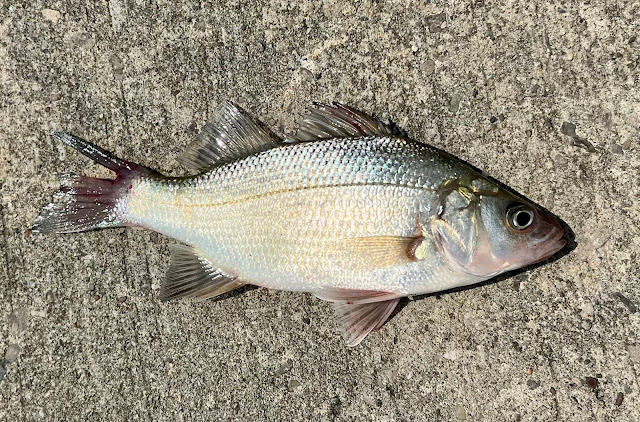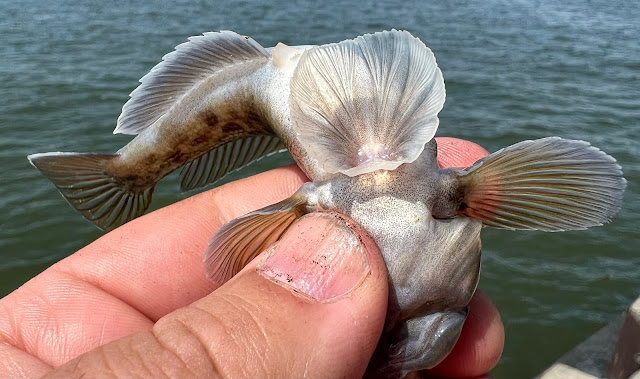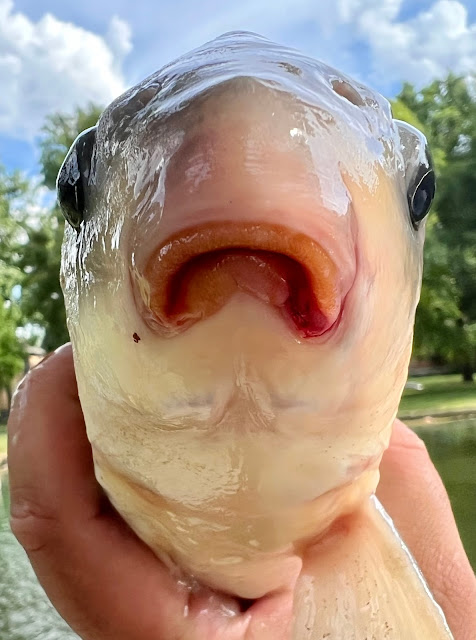Every once in a while, I get the urge to road trip. This, combined with the fact that I'm seriously running out of plausible new fish species anywhere near home, usually results in hours upon hours of driving for increasingly smaller and smaller fish. This would likely bother normal people. But normal went out the window some time ago. They all count the same in my book. So early last summer, when the urge struck, I considered my options. California still ranks high on my wish list and there are dozens of targets there. But that's two whole states away, and I mean two full size western states, not those little eastern fun-size ones like Rhode Island or Delaware (random factoid: the county I live in is over 4 times larger than the entire state Rhode Island). British Columbia is just to my north and there's interesting things there too if I go far enough. Idaho is just one state away, but I grew up there so I've caught most of those as well. But there are still a few points of interest worth mentioning there. Bear Lake has some really interesting endemic species that I'll chase some day, but that is very seasonal. In the end, I ended up trying the shotgun approach. I picked out 7 or 8 different spots to try, all in Idaho, and none really all that close together. I knew they wouldn't all work out, but I was willing to bet that some of them would, and this would definitely scratch my itch to hit the open road.
The first spot on the to-do list was a solid 10 hr drive, and ended up being the strangest Idaho fishing spot I've ever encountered. A buddy in the Boise area was kind enough to share some spots including this first one, which was somewhere in the Snake River basin (which narrows it down to about 72,000 square miles, or 59 Rhode Islands if you prefer that unit of measurement). It was a small stream fed by a hot-spring which regulated the water temperature to be just right for tropical fish. So humans being how humans are, they have illegally released several varieties of tropical aquarium fish into the system here over the years. Speaking as a fisheries biologist: please DON'T do this, as it can be terrible for the native fish communities. Speaking as a fish species hunter: though I disagree wholeheartedly with the introduction of these fish where they don't belong; if they're there, I will still definitely go catch them, and add them to my list. Waste not, want not after all.
So anyway, that is how I found myself on a stream bank in Idaho, fishing for fish that you would normally find either in Petco, or their native range in Africa. It was actually a blast, and the colors on some of those little fish were really spectacular. The first fish to come in was also the first new species of the day, the Nile Tilapia.
 |
Species 190, the Nile Tilapia. The most blandly colored of the species I encountered at this spot.
|
The next one to pop up has caused me a good deal of heartburn as I am nowhere near 100% certain on the identification. I was told they were Red Zebra Cichlids (Metriaclima estherae), which despite their name, come in both both blue and orange varieties. I am by no means a cichlid expert, and wont dive into all the details and discussions that I've read about these particular fish, but suffice it to say, the general consensus among folks who have fished at this spot now seems to be that these are likely not pure M. estherae, but rather some hybrid mix of more than one species, which I don't typically count on my list (at least not on the main spreadsheet tab). I'm leaving it there for now though as I don't have anything even closely related on the list. I'm still calling it M. estherae for now, but maybe a better designation would be Mbuna sp. or Mbuna hybrid. Honestly though, all this heartburn seems to just be over complicating things. The whole point of the game is to have fun and catch things that I find interesting. I like the weird and/or pretty ones the most. And just look at this thing. It's definitely weird AND pretty!
 |
These came in a variety of hues and shades. This one had the brightest blue of the ones I caught.
|
 |
So blue. So shiny.
|
 |
These little drops of paint on the anal fin are called egg spots, a common feature among many cichlid species. They apparently aid in the courtship and spawning process.
|
 |
There were also plenty of more blandly colored individuals like this.
|
The whole stream was full of fish, all of which were clearly visible, and all of which were eager to attack a bait. So I kept picking out the ones that looked different. This process resulted in two more species (without any heartburn this time), the Redbelly Tilapia and the Auratus Cichlid.
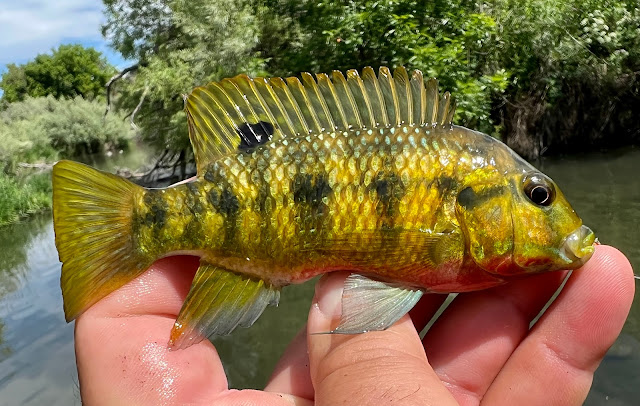 |
The Redbelly Tilapia. It's called that because it has a red belly.
|
 |
This individual was actively guarding a nest. It went right back to it after this quick photo op.
|
 |
These Auratus Cichlids made up for their tiny stature by packing in as much color as possible. Shown here are a male (top) and a female (bottom).
|
 |
I was hoping that something new would come from a school of the tiniest fish in the creek, but they turned out to be these juvenile tilapia.
|
 |
I was also hoping that these livebearers would turn out to be Guppies, but I believe they were Western Mosquitofish (not a new one sadly), female on top and male on bottom.
|
Since I could clearly see all the fish in the little stream, it was pretty easy to tell when I had caught all the different varieties available, so back on the road I went. The next spot on the agenda resulted in a new sculpin species and some beautiful scenery.
 |
Waterfalls and springs were all around on the way to this spot.
|
 |
This Shoshone Sculpin was the last new one of the day, and one of only two native fish I would catch on this trip.
|
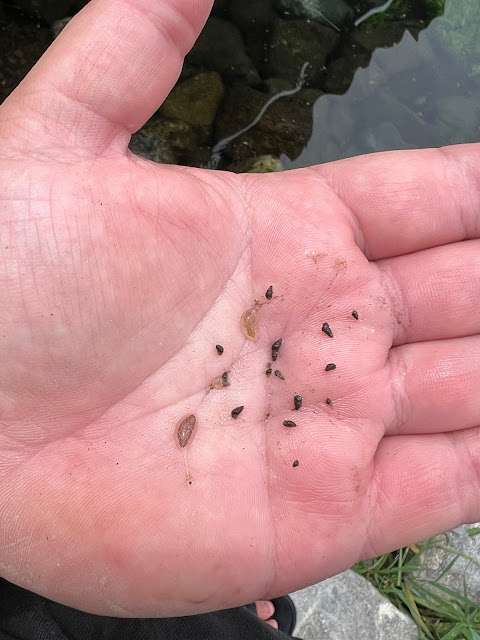 |
Another example of things that shouldn't be in Idaho, these New Zeland Mud Snails were all over the rocks here. These are an invasive species fishermen are asked to clean and dry their wader boots and gear after using them to avoid spreading these to new waters. As you can see, they're very tiny, especially their eggs, so they'd be easy to miss!
|
Next on the agenda, was to try for a flathead catfish at Brownlee reservoir but the river was high and muddy, the weather was very windy, and all the campgrounds were full, so I decided to bag it and head for my parent's house. What's another 5 hrs driving when you're this far into it anyway?
The next morning I decided to hit one of my old high school catfish spots. I had a sneaking suspicion that the timing might be right to luck into a species that I had on my wish list for the better part of a decade. I cast out some small baits and prepared to wait this critter out. No waiting was necessary though even by the standards of my short attention span, since roughly 48 seconds later, I had a small fish on. It was the right size and color, but I held my breath as I hoisted it up the 10 feet from the water. Success! I had my first and still the only Sand Roller I've ever seen. These odd little native fish are one of just two species in the family Percopsidae, the other species being the Trout Perch, which are found in quite a few Midwestern and Great Lake states. Sand Rollers on the other hand are endemic to the Columbia River Basin in Washington, Idaho, and Oregon.
 |
Here's a picture I've wanted to take for YEARS. I can see how their cousin the Trout Perch got it's name though, they kind of look like perch, and they have an adipose fin like a trout.
|
 |
See? Cute little adipose fin. You can tell a hatchery reared Sand Roller from a wild one as they will have an adipose clip. Just joking, that's not a thing.
|
After adding this one to the list, there really wasn't much point sticking it out there, even though I'd been there under 5 minutes. So we decided to go do a little carp fishing before starting the drive back home. The species total for the trip was at an incredible six (though that does still include the heartburn inducing bright blue cichlid), which was more than I had dared hope for. That brought the total up to 195. Two hundred was within range, especially with an upcoming trip to Ohio over the 4th of July. I try not to count my chickens before they hatch, but I did cross all my fingers and toes just in case.
 |
I even managed a photo of my dad with one of his carp from that morning.
|

.JPG)

